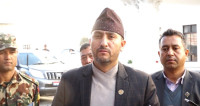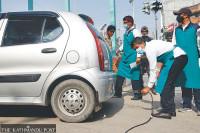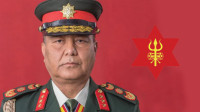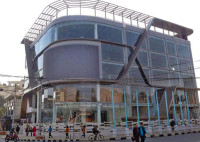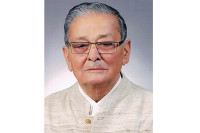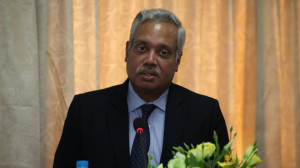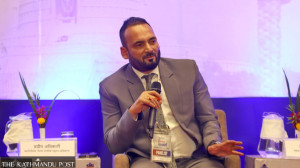National
More pro-monarchy forces join hands, announce new phase of protests
Lingden, Thapa and Bista, among others, to join the agitation under Subedi’s leadership.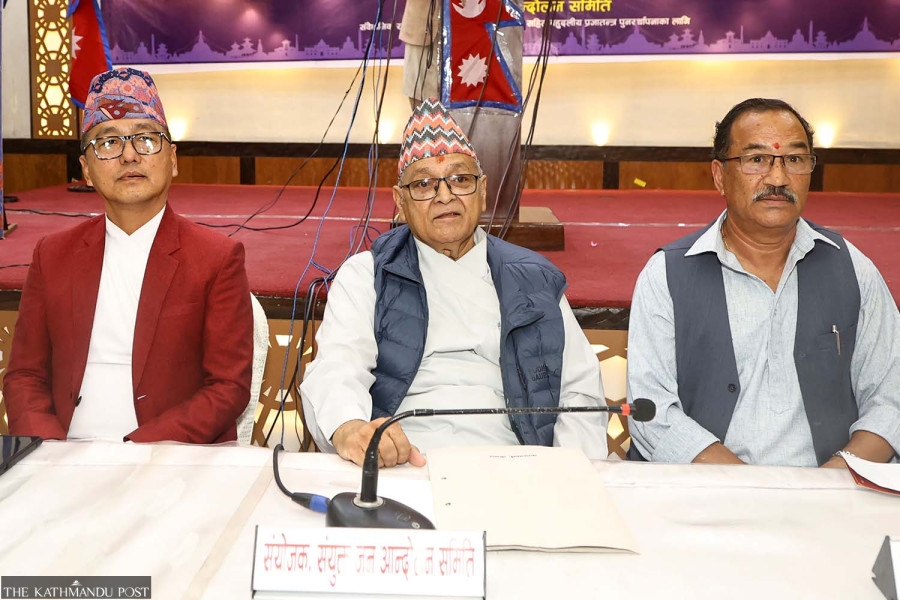
Post Report
After prolonged disputes and confusions, pro-monarchy forces have vowed to come together again to fight for the reinstatement of Hindu monarchy, which was abolished in 2008 in the country.
Having failed to make any significant progress in their objective through divided movements, the pro-Hindu and royalist groups have now united under the leadership of 87-year-old Nabaraj Subedi, a Panchayat-era leader.
Previously, the monarchist leaders refused to cooperate with each other due to bitter rivalries. Although there was a consensus among them on the need for a unified movement, disputes over leadership caused persistent friction.
In a notable development, leaders from various royalist factions joined the press conference organised by the Subedi-led Joint People’s Movement Committee on Thursday.
Rajendra Lingden, chair of Rastriya Prajatantra Party (RPP), and Kamal Thapa, chair of Rastriya Prajatantra Party Nepal (RPP-Nepal), had bitter relations after Lingden defeated Thapa in the election for the RPP’s chairmanship in December 2021.
Thapa subsequently quit the RPP and formed the RPP-Nepal.
They distanced themselves from each other even until March 17 when various pro-monarchy forces announced the Joint People’s Movement Committee and declared Subedi as its coordinator.
The committee later organised the protest at Tinkune, Koteshwar on March 28 that escalated into violence, resulting in two fatalities and extensive damage to both public and private properties.
The RPP was divided over the participation in the Subedi-led protest. Eventually, the party expressed its solidarity to the protest but didn’t join in its full strength. But the party’s senior vice-chair Rabindra Mishra and general secretary Dhawal Shamsher Rana actively led the protesters. Police arrested Mishra and Rana. While Rana has been released, Mishra is still in the police custody.
The RPP later held separate protests demanding reinstatement of Hindu kingdom and release of its leaders including Mishra.
While Lingden supported the March 28 protest, he later distanced himself from its violent outcome. Following the incident, Lingden refrained from participating in any further activities organised by the Joint People’s Movement Committee and did not fully endorse programmes initiated by other royalist factions.
However, a notable shift was first observed when Lingden appeared at a protest organised by the Thapa-led RPP-Nepal on April 28 at Shantibatika, Ratnapark.
The shift reportedly followed a meeting between Lingden and former king Gyanendra Shah at Nirmal Niwas on April 18, alongside other RPP leaders.
On Thursday, all the pro-monarchy forces attended the press meet under Subedi’s leadership and announced an indefinite agitation commencing on May 29. “The movement will continue until the monarchy is reinstated,” Subedi declared.
Subedi, Lingden, Thapa, and Keshar Bahadur Bista addressed the press conference.
Both Lingden and Thapa, among other leaders, at the event reiterated that this unity wouldn’t break without achieving the stated goal—reinstatement of Hindu monarchy in the country.
Later, RPP-Nepal chair Thapa described Thursday as a day of satisfaction and pride. “For the first time, all of us nationalist forces have come together for the purpose of reinstating the monarchy and Nepal as a Hindu nation,” he wrote on X. According to him, a total of 44 groups including political parties have joined hands to launch the new phase of the joint agitation. Leaders said further details of the campaign will be released later.
Notably, the royalist factions that had previously rejected Subedi’s leadership acknowledged his role at Thursday’s event. “Our movement was fragmented earlier, but Thursday’s event has unified us,” Sagun Sunder Lawoti, a spokesperson of the RPP, told the Post.
The pro-monarchy bloc has also released a 14-point commitment paper, asserting that the current political system cannot resolve the pressing problems faced by the country. They have called for the revival of a democracy that includes a constitutional monarchy, reinstatement of Nepal as a Hindu nation, and the implementation of a two-tier federal system while removing the provincial layer.
The committee emphasised that all movement-related activities, including civil disobedience and satyagraha (non-violent resistance), would be conducted peacefully.
Furthermore, the royalists demanded the formation of a powerful high-level judicial commission to investigate the wealth of individuals who have held public office since the political change of the 1990s.
Despite the new-found unity among the royalist forces, political analysts remain sceptical of the prospect of it gaining significant momentum. “Since they have not expanded their constituency in the general masses, it is unlikely their movement will reach greater heights,” said political analyst Chandra Dev Bhatta. “Beyond criticising the current system, they lack a clear vision to lead the country forward.”
Bhatta believes that the newly announced agitation by the royalists may prove weaker compared to the earlier one.
In response to the attempts made to revive the monarchy, the ruling CPN-UML, during its secretary-level meeting on May 4, concluded that the pro-monarchy movement was weakening.




 8.12°C Kathmandu
8.12°C Kathmandu